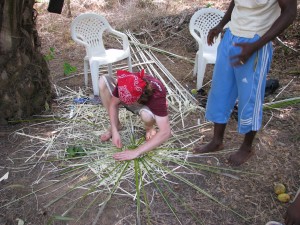Musing and interpretation of Chapter 2 “First Contact as a Spiritual Performance: Encounters on the North American West Coast” from Myth and Memory: Rethinking Stories of Indigenous-European Contact by John Lutz
2:2 Question 3 – What do you make of this reading? Am I being fair when I point to this assumption? If so, is Lutz being fair when he makes this assumption?
Preamble: I failed to come to a clear initial impression of Lutz’s work, I had to reread the chapter “First Contact as a Spiritual Performance: Encounters on the North American West Coast” several times before I felt I had grasped the material adequately to provide any insight. The overarching goal is to establish the importance of performance in communication, especially when contextualized by first-contact situations, and to highlight the importance of spiritual belief systems as context for dialogues.
Early in “First Contact as a Spiritual Performance“ Lutz writes:
“One of the most obvious difficulties is comprehending the performances of the indigenous participants. One must of necessity enter a world that is distant in time and alien in culture, attempting to perceive indigenous performance through their eyes as well as those of the Europeans.” (32)
These sentences set the stage for the chapter describing first-contact from the indigenous point of view contextualized by spiritual belief systems. Within these lines is an inherent bias, one that the readers (or society at large) belongs to a European tradition, or that such a tradition is disadvantaged in understanding performance. Hence the necessity to enter a distant world. This chapter continues to contextualize first-contact from the Indigenous perspectives with several examples including incorporation into spiritual belief systems. Europeans ideas are touched upon in through the chapter but there is a distinct lack of perspective provided to the reader in the spiritual grounding of explorers, colonizers, and settlers.
Lutz’s assumption that the reader is from a Western European background is a relatively fair one to make, as the vast majority of readers will likely have less exposure or knowledge about traditional North Western Indigenous spiritual and historic ideologies than about dominant European ones. Globally, more people will come from backgrounds touched in some way by European colonization than by the relatively fewer familiar with indigenous cultures in Canada, much least a distinct North Western region. However, I believe that lacking a detailed and full explanation of how European spiritualism plays into communication weakens the overall argument that spirituality shapes understanding as well as the need for entry into a “new world” for perception of performance.
Unbalanced explanation of spirituality with a heavy focus on the Indigenous leads the reader to the assumption that it is more difficult for the European to understand the Indigenous performance then vice versa. I do not believe this was Lutz’s goal, but it may well have been. Much of his chapter is devoted to explaining how explorers fit spiritual and supernatural histories, stories, and myths of indigenous people that placed them upon a pedestal – as either supernatural beings or even as deities. Lutz explains that this fit the colonial idea of superiority predicated on civilization, technology, and religion. This explanation of colonization certainly lends itself to the notion that European misunderstanding of Indigenous communication was indeed more prominent in the history of first-contact.
Misunderstanding was not a one way street. Lutz recounted the story of Ts’mysen George McCauley (provided by anthropologist William Beynon) which provides perspective of a Gitrhala man’s interpretation of first contact (pages 33-34). Herein, the Gitrhala man is constantly in awe of his captors and when he is ordered to cut up fish, they stop him and do it faster with their knives, when asked to light a fire, they do so more rapidly with flint. Eventually, he understands that though spiritual or magical in nature, these men mean him no harm. To me, it seems as though the indigenous man misunderstood the desires and aspirations of Europeans who throughout the entire story are never made out to be uncomfortable, afraid, or lacking understanding of the situation. They communicated to the Gitrhala man instructions on building a fire, cooking, and even showing them to his home without many problems. I put forward that this is evidence that Indigenous peoples were themselves more disadvantaged in communication in first contact performance scenarios. European explorers had a long history of colonization and inter-cultural trade by the time they landed in the Americas, especially by the time they arrived in the North West. Thus, Europeans had an upper hand in experience interpreting performances.
Lutz brings up the nuances of cultural constrained gestures as an example for how difficult it is to understand what may or may not cause offence or instigate violent reactions. I argue that while gesticulation is highly culturally constrained, and we judge “us and them” based on body language, when we encounter obviously culturally distinct other we do not take offence so easily. Indeed, there is a long human history of meeting strangers nomads, travellers, and merchants with whom verbal communication may be impossible. First contact happens daily between people from diverse backgrounds. Ubiquitously humans manage to communicate through performance with the shared understanding that the message may be muddled. With that shared understanding we are not easily offended by gestures or actions we would normally see as transgressions. Rather, these symbolic modes of communication may direct or shape our categorization of the “other” in some way.
Almost there. Hang in a little longer.
Is it then necessary for one to enter a world that is distant in time and alien in culture to attempt to perceive indigenous performance?
I respond with an adamant and resounding “No”. Not only do I disagree, but I suggest that the opposite is true. The elegance of the human condition is we can use our shared experiences to communicate. This can be achieved non-verbally through dance, acting, and performance. We can express birth and death, day and night, hot and cold, limitless dichotomies. The beauty of this form of communication is that it transcends local constraints of history, culture, and spirituality. It is what builds the common ground of humanity between all of us. We may be limited to our experiences, but they allow us to transform our common ground into an arena for communication.
Understanding the spirituality and culture of people is fundamental to clear and concise communication. However, I caution the reliance of this form of “understanding” in perception of other people. We often learn some things about different perspectives and assume we understand all. It is this hubris that is our downfall, because the moment we stop questioning whether or not we are being understood or are understanding each other correctly we can err. An example of this caution is the W4D Indian as portrayed by the Canadian media, CBC phrases it more eloquently that I ever could. Once the dominant culture believes they understand another communication of stories really breaks down.
In summary to this long and rambling road: performance is nuanced but can be globally understood with effort. I disagree with Lutz’s comment that the most obvious difficulty of first contact histories resides in the perception of performances. Ultimately, it is the mutual desire to communicate that gives rise to both perception and performance. The most difficult part of first contact histories is simple that we cannot trust or know what really happened – but perhaps it is the stories that are told that are more important.
Thanks for making it to the end!
As always, comments, criticisms, concerns, and questions are most welcome.
My opinions and bias is formed by my own experiences of non-verbal communication – this reading and response spoke to me on several levels and reminded me of some time spent with far flung amigos…





Hello Duncan!
I really appreciated your discussion of the tremendous value of artistic performance in communication between cultures. Especially interesting to me was how you described a special performance space, “where we are not easily offended by gestures or actions we would normally see as transgressions” (MacGillivray). You also highlighted some pitfalls we may get stuck in when we rely too much on our own narrow perceptions of these performances, notably the blatant stereotyping of First Nations cultural performances discussed in the CBC article. Where do you suppose a boundary is drawn between using a performance to understand a culture, and using it to form cultural stereotypes? From my view, it seems that we must constantly be searching for new performances from which we can reimagine our views of a culture or person, even, if we hope to avoid stereotyping. So in this way, cultural performances offer at best an instantaneous glimpse of cultural understanding; the plurality of creation stories or contact stories shared by First Nations people today as well as their evolution over the life of the storyteller provides some evidence for this argument. Let me know what you think about this, or if you have any examples from your experience that fit this idea.
Cheers,
Keely
Hi Duncan,
I enjoyed your writing as well as your insights! thanks for going into the detail that you did to explain your thoughts and connect them to the themes of cultural and spiritual communication around first contact. I was interested in your opinions about the assumptions that are made (on both sides) that lead to communication breakdown and misunderstandings. You highlight this idea of misunderstanding nicely throughout your post. As a communication inevitability, misunderstanding happens on many levels and can lead to many different interpretations of intended communication. As you say, when people generally communicate there is a “shared understanding that the message may be muddled – when this understanding is viewed in the context of first contact, there is no surprise that the bewilderment went both ways (for Europeans and First Nations Peoples). When considering communication in this way, we see the importance and universality of performance in communication as a way to bridge gaps and initiate dialogues. Thanks again for your post, Duncan.